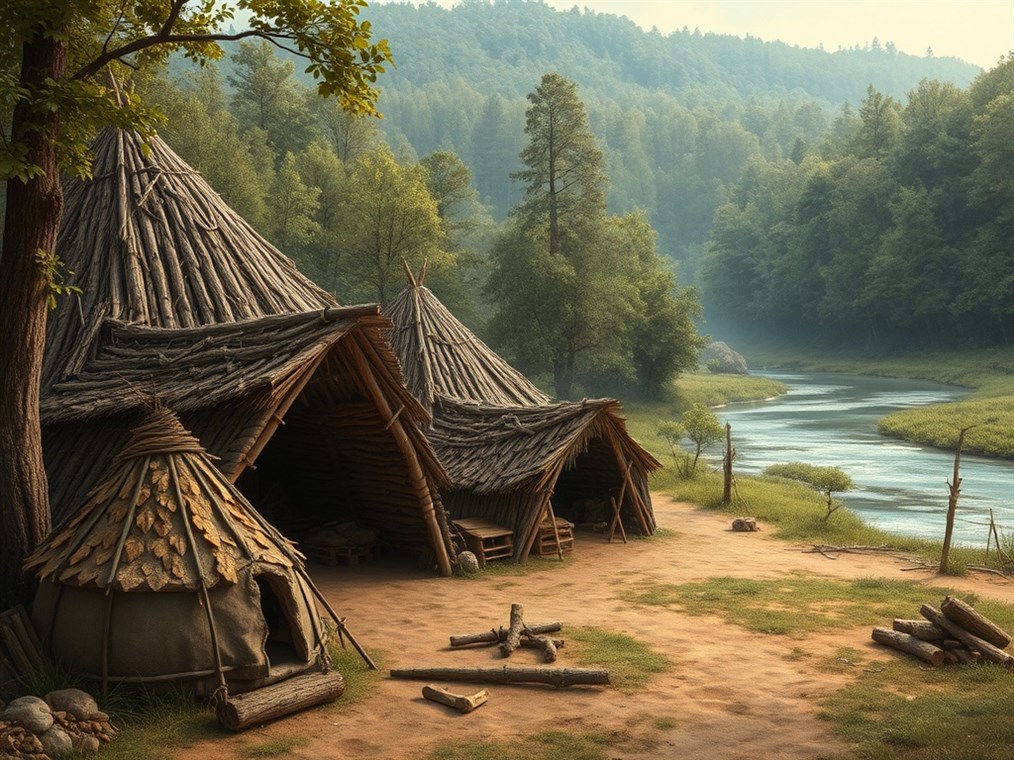
What Were Mesolithic Houses Made Of? (A More Human Look)
FactsWhat Were Mesolithic Houses Made Of? (A More Human Look)
Ever wondered what it was like to build a home back in the Mesolithic period? Forget bricks and mortar; these folks were all about resourcefulness and making the most of what Mother Nature provided. The Mesolithic, or Middle Stone Age, was a time of huge transition, roughly 15,000 to 5,000 years ago. Think of it as the bridge between the old hunter-gatherer days and the dawn of farming. As the ice age thawed, forests grew, and coastlines shifted, people had to get creative with their shelters.
So, what did they actually use to build these homes? Well, it really depended on where they were. But let’s take a look at some of the common building blocks.
Wood was a big one, especially if you were living in a forested area. Imagine using sturdy wooden posts to create a frame, maybe a circle or a cone shape. We know they did this at places like Star Carr in England. Then, to keep out the wind and rain, animal hides were often stretched over the frame. Makes sense, right? They were hunting animals anyway, so why not use the skins?
But it wasn’t just wood and hides. Think about readily available materials like reeds, grasses, and even moss. These were perfect for roofing and insulation. Turf, those blocks of soil held together by plant roots, could also be stacked up to create cozy, surprisingly warm walls. Stone was sometimes used too, especially for foundations or to prop up posts. If you lived near the coast, stone was a no-brainer.
And here’s where it gets really interesting. In some places, where wood was scarce, they used bones! Mammoth bones, to be exact. Can you imagine building a house out of mammoth skeletons? The site of Mezhirich in Ukraine is famous for this. Talk about making the most of what you’ve got! Other bits and bobs included bark, logs, mud, sod, tall grass, and those trusty wooden poles.
What did these Mesolithic homes actually look like? You had your basic huts – simple, temporary shelters made from branches, leaves, and animal skins. Picture oval or circular shapes, easy to put up and take down. Then there were pit houses, dug partially underground. These were like cozy little bunkers, offering great insulation. They’d cover the top with branches, hides, or thatch. And sometimes, you’d find more permanent dwellings, suggesting people were settling down for longer periods. The Howick house in England, dating back to around 7600 BC, is a great example of this – a circular structure built to last.
Across Europe, archaeological sites give us glimpses into these regional differences. Star Carr in the UK shows those circular wooden structures. What’s really cool is that recent research suggests they even had different zones within the house for different activities. The Howick house, again in the UK, shows a more robust, long-lasting structure. And then you have Mezhirich in Ukraine, with its incredible mammoth bone houses. In Northern Europe, you see everything from simple windbreaks to more solid homes with birch bark and log floors.
Why does all this matter? Well, studying Mesolithic houses gives us a real connection to our ancestors. It shows us how resourceful they were, how they adapted to their environment, and how they started to build communities. There’s even that “eco-home” near Stonehenge, using a tree base as a wall, lined with flint. It shows a pretty sophisticated understanding of sustainable living, even back then.
So, next time you’re thinking about home, remember those Mesolithic pioneers. They might not have had all the fancy materials we have today, but they sure knew how to make a home out of whatever they could find. And in a way, that’s pretty inspiring.
You may also like
Disclaimer
Categories
- Climate & Climate Zones
- Data & Analysis
- Earth Science
- Energy & Resources
- Facts
- General Knowledge & Education
- Geology & Landform
- Hiking & Activities
- Historical Aspects
- Human Impact
- Modeling & Prediction
- Natural Environments
- Outdoor Gear
- Polar & Ice Regions
- Regional Specifics
- Review
- Safety & Hazards
- Software & Programming
- Space & Navigation
- Storage
- Water Bodies
- Weather & Forecasts
- Wildlife & Biology
New Posts
- Diving Deep into Tangerine: More Than Just a Sunny Locale
- Jamaica Backpack Daypack Pockets Shopping – Review
- TEOYETTSF Climbing Backpack Multifunction Military – Buying Guide
- The Curious Case of Cavendish’s Classroom: Where Did This Science Star Study?
- Dragon Backpack Insulated Shoulder Daypack – Buying Guide
- ROCKY Hi-Wire Western Boots: A Rugged Review After a Month on the Ranch
- Vertical Curbs: More Than Just Concrete Barriers
- Regatta Modern Mens Amble Boots – Honest Review
- YMGSCC Microfiber Leather Sandals: Beach to Boardwalk, Did They Hold Up?
- Tangier: More Than Just a Backdrop in “Tangerine”
- DJUETRUI Water Shoes: Dive In or Doggy Paddle? A Hands-On Review
- Barefoot Yellow Pattern Hiking 12women – Is It Worth Buying?
- Koa Trees: How Fast Do These Hawaiian Giants Really Grow?
- DDTKLSNV Bucket Hat: Is This Packable Sun Shield Worth the Hype?